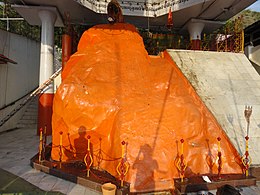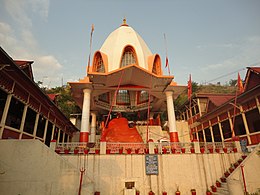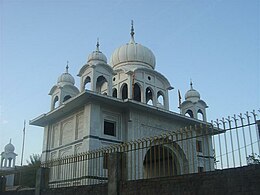Hari Parbat
| Hari Parbat | |
|---|---|
| Koh-i-Maran | |
 Hari Parbat and the Durrani Fort. | |
| Highest point | |
| Coordinates | Coordinates: 34°6′19″N 74°48′58″E / 34.10528°N 74.81611°E |
| Geography | |
| Location | Srinagar, Jammu and Kashmir |
| Parent range | Karakorum |
Hari Parbat ([haːriː pərbət]), also called Koh-i-Maran[1][2][3] ([koːhi maːraːn]), is a hill overlooking Srinagar, the largest city and summer capital of Jammu and Kashmir, India. It is the site of a fort, built in the Durrani era, and of a Hindu temple, mosques, and gurdwara.
Durrani Fort
The first fortifications on the site were constructed by the Mughal emperor Akbar in 1590 who built an outer wall for the fort as part of his plans for a new capital called Nager Nagor. The project, however, was never completed. The present fort was built in 1808 under the reign of Governor Atta Mohammed Khan .
Hindu temple
Hari Parbat is considered sacred by the Kashmiri Pandits who also call it Pradyumna Peeth.[4] The hill hosts a temple of Shakti, who is worshipped there under the name Jagadamba Sharika Bhagawati (or, simply, Sharika). She is depicted as having 18 arms and sitting in Shri Chakra.[citation needed]
Muslim shrines
The southern side of Hari Parbat features Makhdoom Sahib, the shrine of Hamza Makhdoom, a 16th-century Kashmiri Sufi saint locally known as Hazrat Sultan and Sultan-ul-Arifeen.[5][6]
Built below the fort is a mosque dedicated to Shah Badakhshi, a 17th-century Qadiri Sufi saint. The mosque was built by Mughal princess Jahanara Begum.[7]
Gurdwaras
Gurdwara Chatti Patshahi at Kathi Darwaza, Rainwari, is believed to be the place where Guru Har Gobind, the sixth Sikh guru, stayed for few days while travelling through Kashmir.[8][9]
Gurdwara Guru Nanak Dev is a place where Guru Nanak sat and had discourse with people in early sixteenth century. It was earmarked with a pedestal by Mohammad Ata Khan, a general of Akbar who built the Durrani Fort. A small Gurdwara was later built at the place by Guru Har Gobind.[10]
Gallery
- View of the Hari Parbat Temple from the Stairs.jpg
View of the temple from the stairs
References
- ↑ Fernandez, E.E (1889). The Indian Forester. Vol. 15. Roorkee: Thomas Civil Engineering Press. p. 366.
The beautiful expanse of water is situated at the foot of the hill called the Hari Parbat or Koh-i-maran.
- ↑ Asher, Catherine .B (1992). Architecture of Mughal India. Vol. 4. Cambridge University Press. p. 124. ISBN 9780521267281.
In Kashmir's capital city , Srinagar , Akbar had constructed a massive fort on a high hill known as the Koh - i Maran or Hari Parbat overlooking Dal lake .
- ↑ Kashir Encyclopedia (in कॉशुर / کٲشُر). Vol. 1. Jammu and Kashmir Academy of Arts Culture and Languages. 1986. p. 403.
- ↑ Origin Archived 9 May 2012 at WebCite
- ↑ Hamza Makhdum
- ↑ Makhdoom Sahib Shrine
- ↑ Asher, Catherine B. (24 September 1992). Architecture of Mughal India. Cambridge University Press. p. 215. ISBN 978-0-521-26728-1.
- ↑ "Gurudwara Patshahi Chevin, Village Rainawari". AllAboutSikhs.com. Archived from the original on 4 July 2017. Retrieved 15 December 2015.
- ↑ "SRĪNAGAR (34º-5'N,74º-50'E)". eos.learnpunjabi.org. Retrieved 16 March 2020.
- ↑ "Gurdwara Guru Nanak Dev Ji, Hari Parbat, Sri Nagar". www.sikhphilosophy.net. Sikh Philosophy Network. Retrieved 14 September 2019.
External links
- CS1 कॉशुर / کٲشُر-language sources (ks)
- Webarchive template webcite links
- Pages using infobox mountain with deprecated parameters
- Articles with unsourced statements from October 2018
- Hills of Jammu and Kashmir
- Hindu temples in Jammu and Kashmir
- Forts in Jammu and Kashmir
- Tourist attractions in Srinagar
- Buildings and structures in Srinagar












